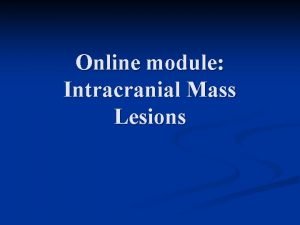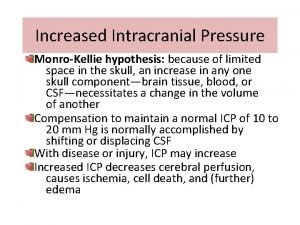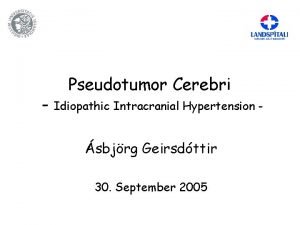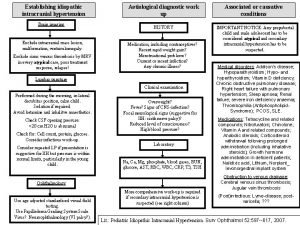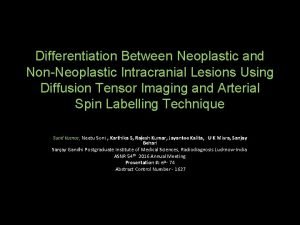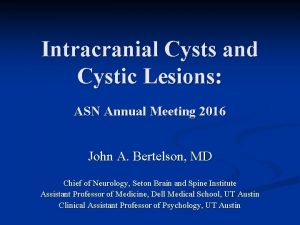Online module Intracranial Mass Lesions Couple of quick













- Slides: 13

Online module: Intracranial Mass Lesions

Couple of quick things As you can imagine, this is a HUGE topic that encompasses parts of Neurosurgery that some individual develop subspecialties within! n Don’t fret. The point here is to develop a general understanding of presentation, what clues the presentation(s) can provide as to the diagnosis, what you should or should NOT do, etc. n

Intracranial Mass Lesions – Differential Considerations n Primary Brain Tumor/Lesion n Including non-neoplastic cysts, congenital, etc. Metastatic Lesion n Trauma (see module on Neurotrauma) n Infection n Vascular (see module on Neurotrauma) n n n Including aneurysms, AVMs, stroke, etc. Inflammatory

Clues to diagnosis… Have an idea of those differential considerations in your mind, to “choose from” when a patient presents. n Mass lesions can present any of a number of different ways, but clues to the diagnosis is often times hidden within the manner in which they present. n

Tumors n Mass effect from tumor itself n Presentation is function of brain compression n A large frontal convexity meningioma may cause arm weakness, slurred speech, gradual confusion, etc. n Mass effect from irritation of brain n Presentation is function of edema/swelling around tumor n A small focus of lung cancer, for example, can incite a large surrounding area of edema/irritation.

Tumors n Tumors usually present insidiously. Most common presentation of brain tumor is progressive neurologic deficit, particularly motor weakness. n Seizures in 26% (especially supratentorial) - any first time seizure in an adult needs thorough w/u to rule out brain lesion. n Posterior fossa tumors commonly present with increased ICP and other symptoms secondary to hydrocephalus. n

Metastatic Brain Lesion Cerebral metastasis is initial presentation in 15% of patients with previously-unknown cancer. n Lung cancer by far most common, followed by breast, kidney, and GI. n

Metastatic Brain Lesion n Question – surgery or not? n Very important to consider patient’s functoinal status at time of presentation. Poor functional status generally = poor surgical candidate.

Surgery for metastatic disease n Solitary lesion Obtain tissue for diagnosis (primary unknown) n Symptomatic and/or life-threatening lesion n Lesion is accessible to surgical removal (i. e. not buried beneath the motor strip) n Good functional status, good relative prognosis n n Multiple lesions Palliative (a lesion is symptomatic/life-threatening) n Obtain tissue for diagnosis n

Intracerebral Infection/Abscess Risk factors: Dental abscess, pulmonary abscess, immunocompromised state, IV drug use, pulmonary A/V fistulas, penetrating head trauma, etc. n Presentation is usually secondary to symptoms of increased ICP, and more acute than tumors but not “sudden. ” Seizures are common, as are focal neurological deficits. n Fever, abnormal labs (ESR, CRP) are clues. n

Inflammatory lesions n Classic presentation would be middle-aged female with hx of MS who presents with 4 to 5 days of new progressive neurologic deficit. No fevers, etc. n Brain imaging shows one or multiple lesions. n n Tumefactive MS can be very difficult to distinguish from tumor, especially glioma.

Intracranial Mass Lesions Trauma patients would present with appropriate history, or physical exam findings c/w that. n Vascular patients present with SUDDEN changes in mentation or neurological status, either from stroke, hemorrhage, etc. n Important thing to always keep in mind in cases of space-occupying lesions in the brain: Do not rush to LP!!! You can cause tonsillar herniation! n

Summary n Keep in mind these six “possibilities” for patients presenting with head lesions (Primary brain tumor, metastatic disease, trauma, infection, vascular, inflammatory), and compare the “logical” presentation for each with your patient’s presentation to help narrow down your differential.
 Intracranial mass
Intracranial mass Quick find vs quick union
Quick find vs quick union Velocity and acceleration quick check
Velocity and acceleration quick check How does meningitis cause increased intracranial pressure
How does meningitis cause increased intracranial pressure Signs of increased intracranial pressure
Signs of increased intracranial pressure Intracranial regulation nursing
Intracranial regulation nursing Decorticate posturing
Decorticate posturing Intracranial hypertension
Intracranial hypertension Mui.ac
Mui.ac Mosby
Mosby Intracranial teratoma
Intracranial teratoma Otogenic intracranial complications
Otogenic intracranial complications Cushing triad
Cushing triad Mosby
Mosby
